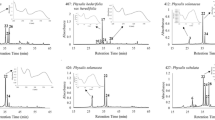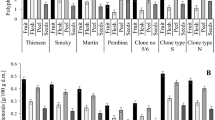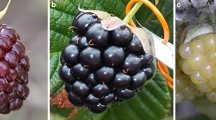Abstract
Bioactivities of persimmon and kiwifruit were studied and compared in connection with their characteristics towards human health. Based on the results of our recently published research, two fruits growing in South Korea persimmon ‘Fuyu’ and kiwifruit ‘Hayward’ were investigated and compared. Spectroscopic, fluorescence and FTIR measurements and radical scavenging reactions were used to compare the qualities of persimmon and kiwifruit. The results of above methods showed that total polyphenol and tannin substances, vitamin C and values of antioxidant capacities were higher in kiwifruit than in persimmon. Phenolics were also characterized by specific IR bands and MS spectra. Antioxidant capacities of polyphenols extracted from the studied fruits correlated with the binding abilities during their interaction with serum albumin, one of the most important proteins in human metabolism. As a result of a complex reaction between the proteins and polyphenols, the fluorescence intensity of proteins decreased and such interaction can be a model in distribution of drugs. Relationship between the most active compounds and their influence on the quality of fruits was established, based on the relatively high bioactivity and quenching properties. In conclusion, kiwifruit and persimmon according to the obtained results contain high amounts of antioxidants and can be widely consumed as fresh, processed and functional foods.



Similar content being viewed by others
References
Dembitsky VM, Poovarodom S, Leontowicz H, Leontowicz M, Vearasilp S, Trakhtenberg S, Gorinstein S (2011) The multiple nutrition properties of some exotic fruits: biological activity and active metabolites. Food Res Intern 44:1671–1701
Park Y-S, Cvikrová M, Martincová O, Ham KS, Kang S-G, Park YK, Namiesnik J, Rombolà AD, Jastrzebski Z, Gorinstein S (2015) In vitro antioxidative and binding properties of phenolics in traditional, citrus and exotic fruits. Food Res Int 74:37–47
Gorinstein S, Leontowicz H, Leontowicz M, Jesion I, Namiesnik J, Drzewiecki J, Park YS, Ham KS, Giordani E, Trakhtenberg S (2011) Influence of two cultivars of persimmon on atherosclerosis indices in rats fed cholesterol-containing diets: investigation In vitro and in vivo. Nutrition 27:838–846
Maulidiani M, Mediani A, Abas F, Park YS, Park YK, Kim YM, Gorinstein S (2018) 1H NMR and antioxidant profiles of polar and non-polar extracts of persimmon (Diospyros kaki L.)—metabolomics study based on cultivars and origins. Talanta 184:277–286
Maeda H, Akagi T, Tao R (2018) Quantitative characterization of fruit shape and its differentiation pattern in diverse persimmon (Diospyros kaki) cultivars. Sci Hortic 228:41–48
Ma T, Lan T, Ju Y, Cheng G, Que Z, Geng T, Fang Y, Sun X (2019) Comparison of the nutritional properties and biological activities of kiwifruit (Actinidia) and their different forms of products: towards making kiwifruit more nutritious and functional. Food Funct 10:1317–1329
Park YS, Polovka M, Martinez-Ayala AL, Gonzalez-Aguilar GA, Ham KS, Kang SG, Park YK, Heo BGu, Namiesnik J, Gorinstein S (2015) Fluorescence studies by quenching and protein unfolding on the interaction of bioactive compounds in water extracts of kiwifruit cultivars with human serum albumin. J Lumin 160:71–77
Hamid Abdul NA, Mediani A, Maulidiani M, Abas F, Park YS, Leontowicz H, Leontowicz M, Namiesnik J, Gorinstein S (2017) Characterization of metabolites in different kiwifruit varieties by NMR and fluorescence spectroscopy. J Pharm Biomed Anal 138:80–91
Sinisi V, Forzato C, Cefarin N, Navarini L, Berti F (2015) Interaction of chlorogenic acids and quinides from coffee with human serum albumin. Food Chem 168:332–340
Perez-Burillo S, Oliveras MJ, Quesada J, Rufian-Henares JA, Pastoriza S (2018) Relationship between composition and bioactivity of persimmon and kiwifruit. Food Res Int 105:461–472
Park YS, Im MH, Ham KS, Kang SG, Park YK, Namiesnik J, Leontowicz H, Leontowicz M, Trakhtenberg S, Gorinstein SQ (2015) Quantitative assessment of the main antioxidant compounds, antioxidant activities and FTIR spectra from commonly consumed fruits, compared to standard kiwi fruit. LWT Food Sci Technol 63:346–352
Singleton VL, Orthofer R, Lamuela-Raventos RM (1999) Analysis of total phenols and other oxidation substrates and antioxidants bymeans of Folin–Ciocalteu reagent. Methods Enzymol 299:152–178
Broadhurst RB, Jones WT (1978) Analysis of condensed tannins using acidified vanillin. J Sci Food Agric 29:788–794
Ozyurek M, Guclu K, Bektasoglu B, Apak R (2007) Spectrophotometric determination of ascorbic acid by the modified CUPRAC method with extractive separation of flavonoids–La (III) complexes. Anal Chim Acta 588:88–95
Benzie IFF, Strain JJ (1996) The ferric reducing ability of plasma (FRAP) as a measure of antioxidant power: the FRAP assay. Anal Biochem 239:70–76
Apak R, Guclu K, Ozyurek M, Karademir SE (2004) Novel total antioxidant capacity index for dietary polyphenols and vitamins C and E, using their cupric ion reducing capability in the presence of neocuproine: CUPRAC method. J Agric Food Chem 52:7970–7981
Re R, Pellegrini N, Proteggente A, Pannala A, Yang M, Rice-Evans C (1999) Antioxidant activity applying an improved ABTS radical cation decolorization assay. Free Radic Biol Med 26:1231–1237
Brand-WIlliams W, Cuvelier ME, Berset C (1995) Use of a free radical method to evaluate antioxidant activity. Food Sci Technol (London) 28:25–30
Cui XX, Zhang XL, Tang HW, Zhang LP, Xu CH, Sun SQ (2012) Study on extracts of active substances from larch bark by FTIR spectroscopy. Spectrosc Spect Anal 32:1810–1814
Leontowicz H, Leontowicz M, Latocha P, Jesion I, Park YS, Katrich E, Barasch D, Nemirovski A, Gorinstein S (2016) Bioactivity and nutritional properties of hardy kiwifruit Actinidia arguta in comparison with Actinidia deliciosa ‘Hayward’ and Actinidia eriantha ‘Bidan’. Food Chem 196:281–291
Maulidiani M, Abdul-Hamid NA, Abas F, Park YS, Park YK, Kim YM, Gorinstein S (2019) Detection of bioactive compounds in persimmon (Diospyros kaki) using UPLC-ESI-Orbitrap-MS/MS and fluorescence analyses. Microchem J 149:103978
Li XJ, Wang XY, Yuan J, Lu M, Sun XY, Wang RH, Quan ZJ (2013) Determination and comparison of phenolics in apple vinegar, persimmon vinegar and kiwifruit vinegar. Shipin Yu Fajiao Gongye 39:186–190
Veberic R, Jurhar J, Mikulic-Petkovsek M, Stampar F, Schmitzer V (2010) Comparative study of primary and secondary metabolites in 11 cultivars of persimmon fruit (Diospyros kaki L.). Food Chem 119:477–483
Xia HY, Yang Y, Xia LH, Yang TT, Ruan XF (2014) Variations in total phenols and condensed tannins contents in persimmon fruits from different varieties during ripening. Shipin Kexue 35:66–71
Pu F, Ren X (2014) Ascorbate levels and activities of enzymes related to the glutathione-ascorbate cycle in fruits of Chinese persimmon cultivars. Hortic Environ Biotechnol 55:315–321
Tang M, Li F, Huang HQ, Zhou XH, Tang SJ, Hou J (2016) The comparison in antioxidant activity of alcohol extracts from eight kinds of fruit in Wulingshan region. Guangzhou Huagong 44:79–80
Dalvi LT, Moreira DC, Alonso A, de Avellar IGJ, Hermes-Lima M (2018) Antioxidant activity and mechanism of commercial Rama Forte persimmon fruits (Diospyros kaki). Peer J 6:e5223
Jang IC, Jo EK, Bae MS, Lee HJ, Jeon GI, Park E, Yuk HG, Ahn GH, Lee SC (2010) Antioxidant and antigenotoxic activities of different parts of persimmon (Diospyros kaki cv. Fuyu) fruit. J Med Plants Res 4:155–160
Ricci A, Olejar KJ, Parpinello GP, Kilmartin PA, Versari A (2015) Application of Fourier Transform Infrared (FTIR) spectroscopy in the characterization of tannins. Appl Spectrosc Rev 50:407–442
Park YS, Im MH, Ham KS, Kang SG, Park YK, Namiesnik J, Leontowicz H, Leontowicz M, Katrich E, Gorinstein S (2013) Nutritional and pharmaceutical properties of bioactive compounds in organic and conventional growing kiwifruit. Plant Foods Hum Nutr 68:57–64
Peng J, Li K, Zhu W, Deng X, Li C (2018) Separation and purification of four phenolic compounds from persimmon by high-speed counter-current chromatography. J Chromat B 1072:78–85
Jiménez-Sánchez C, Lozano-Sánchez J, Marti N, Saura D, Valero M, Segura-Carretero A, Fernández-Gutiérrez A (2015) Characterization of polyphenols, sugars, and other polar compounds in persimmon juices produced under different technologies and their assessment in terms of compositional variations. Food Chem 182:282–291
Li M, Hagerman AE (2013) Interactions between plasma proteins and naturally occurring polyphenols. Curr Drug Metab 14:432–445
An Y, Li Q, Chen J, Gao X, Chen H, Xiao C, Bian L, Zheng J, Zhao X, Zheng X (2014) Binding of caffeic acid to human serum albumin by the retention data and frontal analysis. Biomed Chromatogr 28:1881–1886
Urbaniak A, Kujawski J, Czaja K, Szelag M (2017) Antioxidant properties of several caffeic acid derivatives: a theoretical study. C R Chim 20:1072–1082
Li H, Wu F, Tan J, Wang K, Zhang C, Zheng H, Hua F (2016) Caffeic acid phenethyl ester exhibiting distinctive binding interaction with human serum albumin implies the pharmacokinetic basis of propolis bioactive components. J Pharm Biomed Anal 122:21–28
Acknowledgements
Thanks from all authors of the manuscript to Dr. Elena Katrich from Institute for Drug Research, Hebrew University of Jerusalem, for her assistance in the measuring of some indices in fruits.
Funding
This research received no external funding.
Author information
Authors and Affiliations
Contributions
This study was conceived and designed by YMK and SG. YSP, DB and YKP generated and performed the quality control of the reported data. KSH, AN and SGK performed statistical analyses and drafted the manuscript. YMK, YSP, and SG contributed to the manuscript writing. All authors reviewed and provided comments to the final manuscript (YMK, YSP, YKP, KSH, SGK, DB, AN and SG). All authors read and approved the final manuscript.
Corresponding author
Ethics declarations
Conflict of interest
The authors declare that they have no conflict of interest.
Compliance with ethics requirements
All authors declare that this article does not contain any studies with human or animal subjects.
Additional information
Publisher's Note
Springer Nature remains neutral with regard to jurisdictional claims in published maps and institutional affiliations.
Rights and permissions
About this article
Cite this article
Kim, Y.M., Park, Y.S., Park, Y.K. et al. Phytochemical analysis of two main varieties of persimmon and kiwifruit and their antioxidative and quenching capacities. Eur Food Res Technol 246, 1259–1268 (2020). https://doi.org/10.1007/s00217-020-03486-z
Received:
Revised:
Accepted:
Published:
Issue Date:
DOI: https://doi.org/10.1007/s00217-020-03486-z




